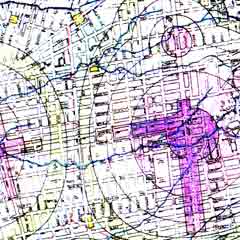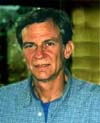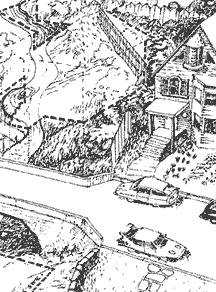BUILDING ECOCITIES:
An Interview with Richard Register
Part three of a three-part series - Page 2 of 3
In this third of his three-part interview with ecoTECTURE, EcoCity designer and builder Richard Register discussed his efforts to rebuild his home town of Berkeley, California, as an ecocity.
(To learn more about Richard Register and his work in EcoCity design, see Part One of his three-part interview with ecoTECTURE in our January / February, 2000 issue.)
ECOTECTURE: What kind of reception is it getting?
RR: A lot of the neighborhood conservatives and the architectural heritage people are quite frightened of any significant change in the city. Even though they might live ten or fifteen blocks from downtown, they don't want to see a taller downtown. Other people have a completely different attitude. People are desperate for housing here. People who think that housing prices are ridiculously high, which they are, tend to think, "Well, why not consider a little more density toward the center of town and provide more housing for people. "
Berkeley is a remarkable place. It kicked out 15,000 people while all the rest of the cities in the Bay Area grew.
ECOTECTURE: Kicked out in what sense?
RR: Allowing slow gentrification and, at the same time, the City's unwillingness to provide any new housing. The reason was that people were reacting against the first big box apartment houses that went right into the middle of residential neighborhoods. They said, "We don't like this in our neighborhoods." They wrote the Neighborhood Preservation Ordinance in Berkeley, which makes it very difficult to demolish a building, which you have to do if you are going to put up a big box in the middle of somebody's neighborhood.
The flaw, in my mind, wasn't that people were inappropriately reacting to what they saw as over-imposing development, but, rather, that they prevented development even where it made sense, where it could house people, work with transit, save energy, and so on.
The development could have gone toward the centers of the neighborhoods in a modest way, and, in a more vigorous way, toward the downtown and a few major sub-centers like the Ashby (avenue) Bay Area Rapid Transit (BART) station, for example. At these locations we have also been insisting on "ecological features" such as solar greenhouses and rooftop gardens, restaurants and mini parks and squares.
ECOTECTURE: Tell me about your book Ecocity Berkeley. When did you write it? What is the general theme? Why did you write it? Is it an accumulation of your ideas that you had already been writing and publishing, or was it a whole new work at the time that your started from scratch?
RR: I wrote it in 1986-87. I thought it was needed. I thought that people weren't covering the idea of the whole city and looking at what its basic principles of ecological organization could be.
ECOTECTURE: Were you thinking of Berkeley as a case study? In other words, there are two ways you could go. You could write a book and just publish it as a little abstract and photocopy it and hand it out to people in Berkeley, or, you could write it as a book and say, "OK, here is a book that could be used by any city anywhere following the same principles and using Berkeley as a case study." Was it more the latter?
RR: The idea was to communicate as broadly as possible but to be well grounded in a particular place. Ecocity Berkeley seems to have communicated better internationally than locally. The book is responsible for invitations to speak all over the world. I've now traveled the equivalent of fifteeen-and-a-half times around the world giving talks on every continent—except Antarctica (laughs).
In any case, the book tries to explore the concept briefly, provide an introduction. Now I'm working on a larger book, Ecocities, which tries to be more detailed and put more of what I've learned, or think I've learned, in the last fifteen years onto the page.
Ecocity Berkeley was written in the Reagan doldrums of the mid-eighties, when a lot of people froze up. It became hard to get anything done for Urban Ecology in those days. While we were in that inactive phase, I wrote the book. Actually, it might have been the silver lining on the nuclear cloud (laughs). The failure of the organization at that time was an opportunity for me to change gears.
I'm actually feeling that way right now. It is so difficult to make progress in ecological city activism that I'm contemplating going into a writing phase. There seems to be a little bit of money to help me with that. There is virtually no money to help with the ecological city design ideas I've been generating in the last two years.
ECOTECTURE: So, the City of Berkeley has been fairly resistant to your "Heart of the City" project?
RR: It's classically resistant to almost any change in the land use pattern and in its architecture. Actually, Berkeley is very flexible in certain, very specific ways. Social justice issues and everyday issues. It is no real stress for anybody, for example, if you outlaw Styrofoam (as Berkeley did several years ago.) That is an easy one. It is important, you know—not to demean it in the slightest—but it is an easy life style change. You just give up on Styrofoam and use paper cups.
The recycling is good here. People from Berkeley have launched some great projects nation-wide, world-wide. The International Rivers Network, an environmental project, is here. The first Ecology Center was in Berkeley, still is. There are very good things happening in the environmental realm here, but not land use change. Very fearful. People here are extremely conservative in regard to changing any buildings. It's not an easy place to work if you want to try to make those kinds of changes, even though it is my home and it is the place I know best.
Another idea I have been floating for a year is called "roll back sprawl." Tools exist for removing development in the wrong place and sending it to the right place.
A transfer development right isn't something you can do only in Berkeley. It is a tool that can be supported by national laws. It could be made more flexible, and it could be made more profitable for developers. If you think the developers are greedy and getting too much profit, tax them, but get the right thing built, the creeks restored, housing constructed, and transit in place.
The idea is to identify tools for transforming the city, for opening up landscapes where sprawl actually exists. Bulldoze suburbia a little bit at a time, while building the new, ecologically healthy, pedestrian city. Of course, you would be looking for buildings that are in bad shape, you would be looking for economic backwaters, and probably Brownfield projects in the city.
When you have the range of city densities in this country running from Boston to Phoenix—as I mentioned, the ratio is seven to one (see Part 1 of ECOTECTURE's Richard Register interview) —you begin to realize that there are even American urban models that a lot of people enjoy that are far denser than Phoenix, that are far denser than average. If you could make American Cities just 25 percent denser on average, you would be saving millions and millions of acres of land—just awesome quantities of land.
So, the challenge is quite exciting, and the tools exist but need to be honed and used.
The idea of a campaign that would identify these tools and promote them is very powerful. I've taken it to leading foundations, all sorts of other environmental groups, food security groups, and no one will give it a high priority. They are doing something else. Though they wouldn't mind seeing such a campaign be launched, they are not helping it happen. It has been very frustrating, so frustrating I'm thinking it might be just easier to write about it instead of trying to actually accomplish it.
ECOTECTURE: Yes, for a period of time at least.
RR: Yes, get it down in one volume so people can see how it plays out in some detail.
ECOTECTURE: Did your current organization, Ecocity Builders, evolve from Urban Ecology? I know that there was a split between you and Urban Ecology at some point. There was some sort of disagreement between you and the management at the time.
RR: Well, the Board. I had a Board or Directors that didn't want to build anything. The original mission of Urban Ecology was to build, and to teach in any way we could. But building was considered to be one of the most important ways of teaching. In 1992 we had a Board of Directors that didn't want to invest in real estate, buy anything, build anything, or, take the responsibility of ownership and management. It was no longer the same old Urban Ecology. It was experiencing a very major mission change, in my sight.
I wasn't that good at the time, and may still not be good convincing people what I thought was important actually was. I kept loosing votes on issues I cared about, so I started another organization to try to get back to what Urban Ecology was originally committed to—innovative, experimental exploring of radical principles and actual building.

EcoCity Drawing by Richard Register
Click for larger image
ECOTECTURE: That's Ecocity Builders?
RR: Yes. But, it is smaller, and Urban Ecology got the history and got a lot of good contacts and so on. They are thriving . . . they are a good group in terms of putting out information. They have a good newsletter and they are good at activist transit support, they promote high density centers near transit, and so on.
Our organization, though, really delves into theory very deeply and takes risks and gets out in the community and invents projects, comes up with new slogans, and discovers that there are various hidden areas tucked here and there into the principles that, if developed, will really flesh them out . . . we have been very international, too. As far as I know, while Urban Ecology reports international developments in their newsletter, they are not very active in the international scene. I think that's important, and fun.
So, they became very different, and, I've stayed pretty similar (laughs).
ECOTECTURE: What is the future boding for you? You mentioned you are possibly going into a writing phase? Any other thoughts or plans down the line?
RR: Several different thoughts. I think the Rollback Sprawl campaign really is a profound concept. Some of us have been thinking these ecocity thoughts for thirty years. Had they at any point been taken seriously, enormous progress could have been made, and made a great deal of difference.
We are still in a position where there are powerful ideas and auspicious signs all around. The Vice President of the United States says that sprawl is a disaster and we have to come up with alternatives. That is an opportunity. There are a lot of opportunities like that. There are some good projects scattered around the country. There are new urban rail lines that have been going in, green belts have been established in various cities and more are being established, there are new growth limits. There is a real fear, also, of confronting the truly higher density with ecologically oriented buildings. And there is the fear of actually moving any buildings and changing any land use. The tools that address that are now getting more clearly defined as well.
In Berkeley, I haven't totally given up. The City has put out a draft General Plan with higher density not in areas, so much, as in corridors. I think that is a mistake. Corridors work well with transit, but better yet is the pedestrian infrastructure, which is around centers. That would be a much better way to go. I'll continue promoting that idea.
ECOTECTURE: So in your model the increase in density in one area becomes a lever relative to the amount of open space in another?
RR: Right. And, what a lever. It is pretty amazing if you stop to think about it. If we run the same numbers I just gave you for Lake Tahoe, where they removed 60 buildings, imagine 60 lower density houses in Berkeley being removed some place or another. Imagine that forty of them are on blocks that have a creek. That's twenty blocks of creek restoration. Imagine that the other twenty are go for gardens. That's a whole lot of land area.
There is a new building being built in downtown Berkeley, the Gaia Building, only seven stories high. (It has) 90 units, 50 percent more than the 60 units in our Lake Tahoe example. Ninety units, and it is only one eighth of a block downtown. When you start looking at what higher density buys you, it is pretty incredible.
It also buys you the fact that people living in the high density areas have good access to transit and don't need cars for most of what they do in their lives. They are living downtown, right next to great transit, right next to the University (of California), and, if we had our way, the creek would be restored right through the middle of downtown so they would have that also. It would be pretty nice. In the meantime, you would actually be taking a significant area of the creek back, you would get significant gardening, and you could have real agriculture starting up. Multiply that (process by) several times the years—fantastic!

